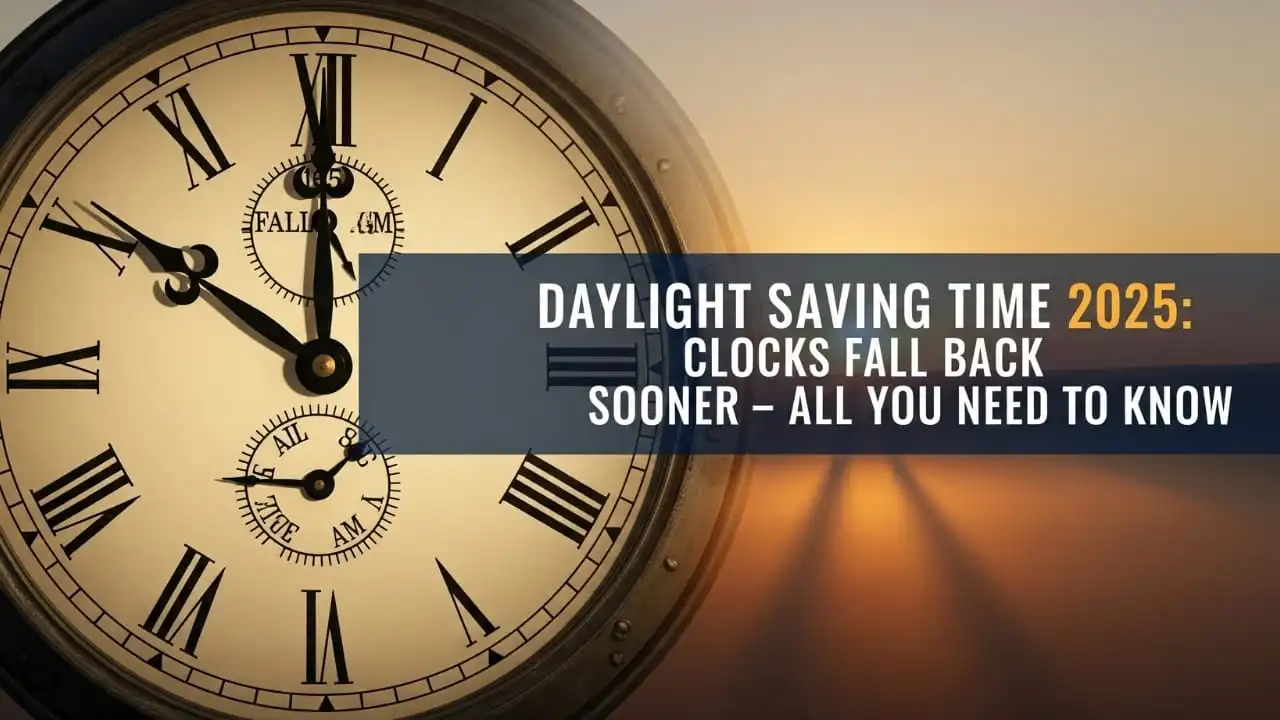A historic scene at the U.S. Naval Observatory, where staff manually reset clocks in 1918, reminds us that the tradition of adjusting time goes back over a century. In 2025, daylight saving time (DST) ends on Sunday, November 2 at 2:00 a.m., when clocks “fall back” one hour (from 2:00 to 1:00 a.m.).
This date is earlier in November than last year’s November 3, making it one of the earliest possible fall-back dates. DST in the U.S. always ends on the first Sunday of November, and in 2025 that Sunday happens to be November 2. The only sooner date it could ever fall is November 1.
In practical terms, ending DST on November 2 means sunsets in early November will arrive sooner than many people expect. After the change, sunrise and sunset will occur about one hour earlier than the day before, so evenings will grow dark more quickly.
Also Read
Why DST Ends Earlier in 2025
The reason for the November 2 date is simply the calendar. Since 2007, federal law has fixed DST to run from the second Sunday in March to the first Sunday in November. In 2025, the first Sunday falls on November 2. That makes it one day earlier than the previous year and the second-earliest possible date (the earliest is November 1).
There’s no new policy here—DST is ending at the usual legal time, but the calendar makes it feel “sooner” than people recall.
Recent DST Dates
| Year | DST Begins (Spring Forward) | DST Ends (Fall Back) |
|---|---|---|
| 2023 | March 12 | November 5 |
| 2024 | March 10 | November 3 |
| 2025 | March 9 | November 2 |
| 2026 | March 8 | November 1 |
| 2027 | March 14 | November 7 |
Thus, in 2025 DST runs from March 9 to November 2.
The History of DST in the United States
The idea of saving daylight has deep roots. Benjamin Franklin once joked about shifting clocks to save candles, but the first U.S. law on DST came during World War I. Congress passed the Standard Time Act of 1918, establishing time zones and setting DST to begin on March 31, 1918. The intent was to conserve fuel by making more use of daylight.
The policy was unpopular, especially with farmers, and was repealed soon after the war. From 1919 through the 1930s, DST was left to localities. New York City and a few other regions kept it, creating a confusing “chaos of clocks.”
During World War II, President Roosevelt instituted year-round DST, called “War Time,” which lasted until 1945. Afterward, states and cities again set their own rules, creating widespread confusion.
In 1966, Congress passed the Uniform Time Act, which standardized DST nationwide. Under this law, clocks would move forward in the spring and back in the fall on fixed dates, unless a state opted out entirely. Hawaii and most of Arizona later chose permanent standard time.
Minor changes followed over the years, including a trial of year-round DST during the 1970s energy crisis. The major modern change came with the Energy Policy Act of 2005, which extended DST beginning in 2007. Since then, clocks shift forward on the second Sunday in March and back on the first Sunday in November.
Attempts to make DST permanent—such as the proposed “Sunshine Protection Act”—have been debated, but no law has passed. For now, the current system remains in place.
What This Means for Daily Life
With clocks moving back on November 2, mornings will be lighter and evenings darker. Many people welcome the extra hour of sleep, though it can still disrupt routines.
Brighter mornings can make waking up easier, but darker evenings shorten daylight for commuting, jogging, or errands. Parents often worry about children waiting for buses in the dark, an issue that influenced past DST debates.
Businesses and travel are also affected. Airlines and trains account for the change in schedules, and international travelers may face temporary differences since Europe shifts its clocks a week earlier. For most people, though, electronic devices update automatically, leaving only a few household clocks to reset.
Health, Safety, and Well-Being
Any clock change disrupts the body’s circadian rhythm. The spring loss of an hour is especially difficult, but even the fall transition can affect mood, sleep, and energy levels. Some research has linked time changes to short-term increases in health incidents such as strokes and accidents, while other studies suggest the fall shift is relatively mild.
Experts recommend preparing for the change by adjusting bedtime slightly beforehand, getting morning sunlight exposure, and practicing good sleep hygiene.
Darker evenings can also contribute to seasonal affective disorder (SAD) and reduce opportunities for outdoor activity. Safety experts caution that more drivers on dark evening roads may lead to a brief rise in traffic accidents.
Pros and Cons of Daylight Saving Time
Pros
-
More evening light in summer for leisure, shopping, and safety.
-
Potential reductions in crime during lighter evening hours.
-
Some economic benefits for retail, dining, and outdoor industries.
Cons
-
Disrupted sleep patterns and health effects.
-
Minimal or negligible energy savings.
-
Inconvenience of resetting clocks and adjusting schedules.
-
Increased risks of accidents during the adjustment period.
What Americans Think
Public opinion is split. Many polls show that a majority of Americans dislike switching clocks twice a year. However, there is disagreement over whether to adopt permanent standard time or permanent DST.
Some prefer standard time for health reasons, while others enjoy the extended evening daylight of DST. Regardless of preference, support for ending the biannual clock changes is growing.
Looking Ahead
For now, the policy remains unchanged. In 2025, clocks will “fall back” on November 2. Whether the U.S. eventually adopts permanent DST, standard time, or keeps the current system remains uncertain.
Until then, prepare for the extra hour of sleep, remember to reset manual clocks, and enjoy the lighter mornings while they last.












